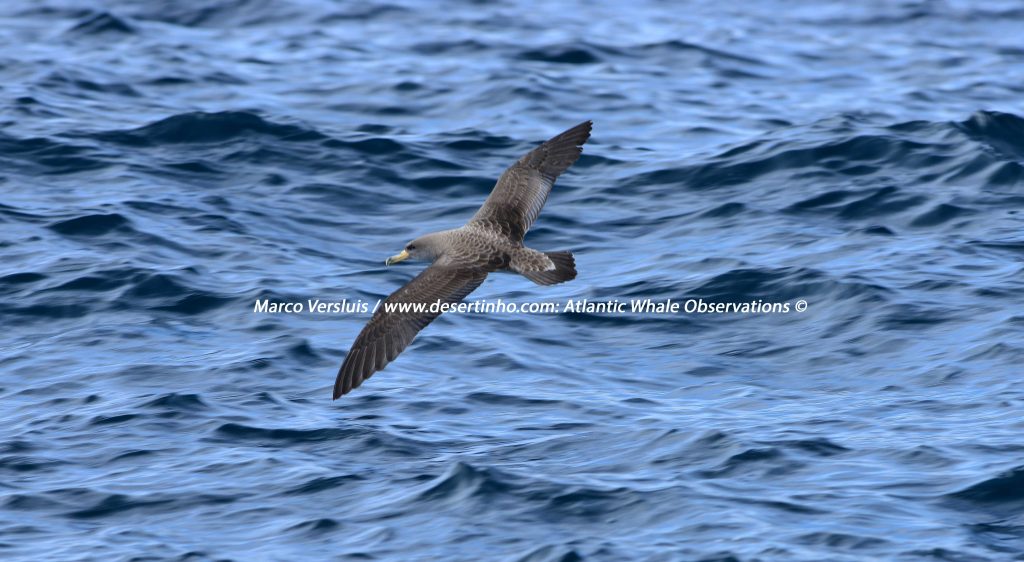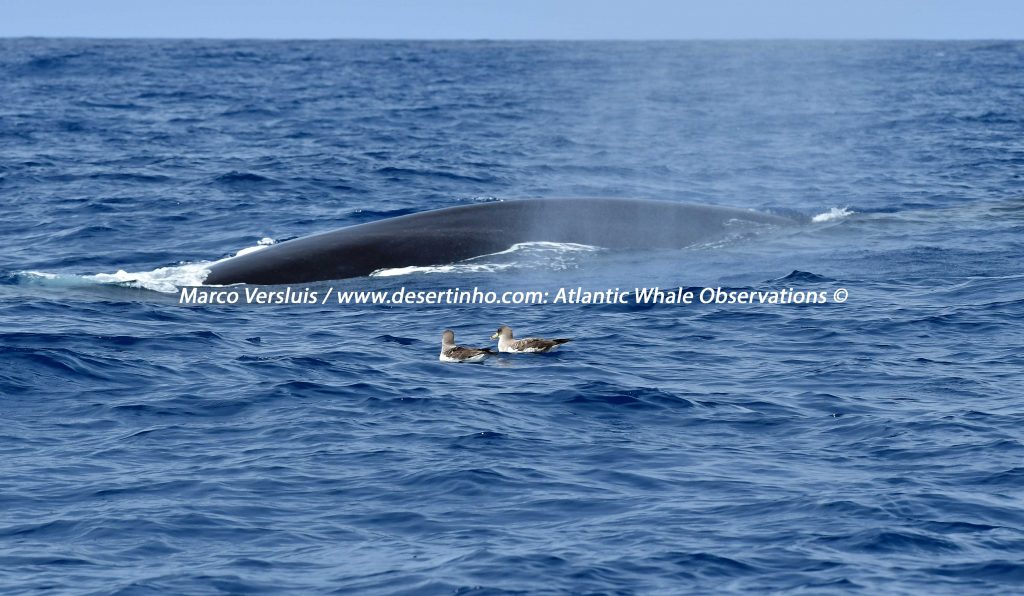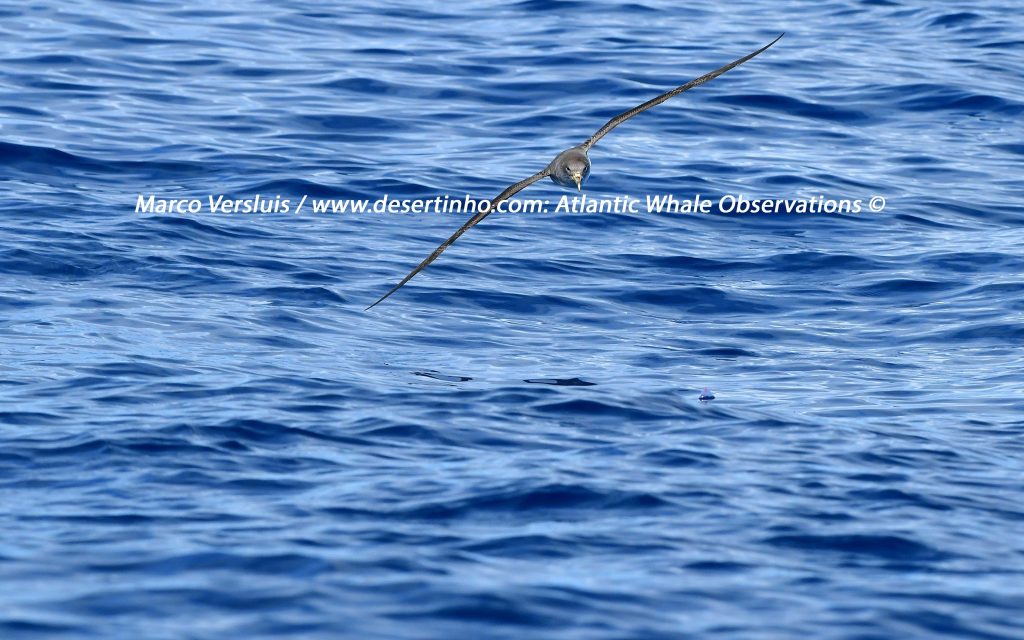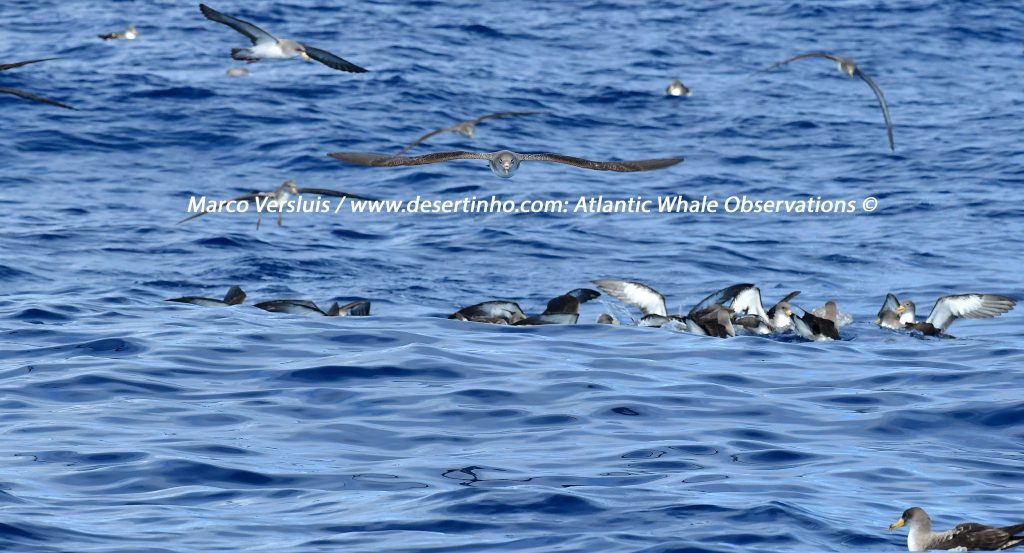Desertinho Atlantic Ocean – The small Atlantic Cory’s shearwater is my Atlantic whale observations guide!
For me personally the Atlantic Cory’s shearwaters (C. d. borealis) are by far the most spectacular seabirds I have ever met on the Atlantic Ocean and it’s islands. So therefore both Cory’s shearwaters, the small and big Atlantic Cory’s shearwater, deserves a very special place on my Blog! For years both Cory’s shearwaters directed me namely to the most beautiful sightings of almost all the whales on my website and so they are responsible for almost 65% of all the photos of whales that I made.
In Europe there are 3 species of Cory’s shearwaters: The Mediterranean Cory’s shearwater (Calonectris borealis) and the small and big Atlantic Cory’s shearwater (C. d. borealis). Within my blog article I just focus on the 2 Atlantic Cory’s shearwaters. The European Atlantic Cory’s shearwaters are mainly living near the Madeirean and Azorean archipelagos. The most important breeding ground for them is by far the archipelago of “Ilhas Selvagens” (Madeira archipelago). Ilhas Selvagens has the biggest number of seabirds per square meter in Europe and is therefore the most important nesting ground for these beautiful seabirds. The Ilhas Selvagens archipelago contains 3 islands and is about 12 hours by boat from the coast of Madeira. The Cory’s shearwaters return every year to these islands for their breeding season that starts in February and ends at the beginning of October. Within that period they just lay 1 egg, their only egg, for the season in between small narrow spaces on the several steep cliffs around the coastlines of these islands. The breeding process of their only egg is a very special one. The Cory’s shearwaters only breed on their egg at night. At daytime they do not need to breed at all on their egg because the rocks provide just the right temperature for their egg. So at daytime all Cory’s shearwaters can be found on the Atlantic Ocean in large groups because the Atlantic Ocean is relative warm at that time and is full of food for them. The remaining months of the year they spent far offshore in the Southern part of the Atlantic Ocean.
So, on the Atlantic Ocean there are just 2 species of Cory’s shearwaters (C. d. borealis): The small and the big Cory’s shearwater. Both seabirds are closely related to each other but are totally different in: Behaviour, size, colour pattern, and in numbers. In general it’s more common you will encounter the small Cory’s shearwater instead of the big Cory’s shearwater. The big Cory’s shearwater is a more solitary seabird and the small Cory’s shearwater lives in quit large groups of individuals (over a 100). The Cory’s shearwater has long broad and slightly rounded wings and it’s beak / bill is stout to medium stout together with a hooked tip. What’s really clear and special to see is that they have on top of thier beak / bill 2 clear visible salt-water filter holes. Both holes are used to filter out the salt Ocean water while they are eating fish. The Cory’s shearwater it’s flight is relaxed and low to the Atlantic Ocean water surface and is it weaving it’s body through the waves rarely beating it’s wings to the Ocean water. Under strong winds it flies higher describing consecutive ‘U’s and when it’s coming lower it seems that it almost touches the water surface. Both Cory’s shearwaters are often traveling together with schools of Tuna fish, several dolphin species, and all sorts of baleen whales. But when it really counts they prefer to travel together with their best Atlantic food supplier namely the common dolphin!
The best chance to see, but especially to hear, both Atlantic Cory’s shearwaters is near the Atlantic waters of the Madeirean and Azorean archipelagos. Nice tell is when you don’t recognize the Cory’s shearwaters in the first place because of their looks you will never forget their sound! Their sound is so special that I promiss you that you will fall in love with it for sure. By day all small Cory’s shearwaters are often floating together in large groups on the Atlantic Ocean just waiting for the things to come. At that time they are all very quit, even silent, and so they don’t say a single word to eachother! But, when sunset sets in they all want to enter the steep cliffs on land at the same time to visit their nests and to find their partner. As soon all small Cory’s shearwaters are entering land they all start at the same time the most beautiful Atlantic concert ever. From my own prospective this concert is equal to an invasion of flying frogs. At the time they are all entering land they need to communicate with their partner, remember they haven’t spoke all day on the Atlantic, and their single chick. When you closely listen to them you should be able to hear the difference between the male and female Cory’s shearwater. The sound of the female Cory’s shearwater is much lower, like she has a cold, than the sound of the male Cory’s shearwater.
When I had the opportunity myself to stay for 3 weeks on the natural reserve of Ilhas Desertas, a natural reserve of the Madeira archipelago, I discovered myself how close I was to the Cory’s shearwaters and how low to the ground their nests sometimes were build! I even discovered some of their nests near the small constructed rock walls close to our compound. That really means in areas where time stood still human and the Cory’s shearwaters can live quit successful and closely together. It’s a miracle that these natural reserves still can provide save nesting grounds for them although these nesting grounds are still under high human pressure. These days for instance the natural reserve island “Deserta grande” can be visited by tourists on a daily bases.
From my point of view it’s quit OK but tourists do have to respect the trails that are especially made for them so they must follow them. However I witnessed myself that people sometimes didn’t followed these trails and went off-road which sometimes had a direct impact on several bird’s nests. But my focus is still to tell you that it’s wonderful that there still are some of these beautiful natural reserves on the Madeirean and Azorean archipelagos that provide save nesting grounds for the Cory’s shearwaters. Without these natural reserves the chance is still there that their nests are robbed by human for instance. Especially on mainland some people are still robbing that only egg out of the Cory’s shearwaters their nests although these seabirds are protected and highly endangered! The reason why people are still doing this is because they say it’s a tradition and because it’s delicious to eat.
The most spectacular and personal moments between me and the Cory’s shearwaters was during my 3 weeks stay on the natural reserve of Ilhas Desertas in 2012. Every night when the sunset was setting in lots of Cory’s shearwaters arrived on the small island to enter the small and tiny rock walls on the island were I stayed. Every night they were flying and singing so close to me that I even felt the air of their beating wings. I was common and accepted by them and I felt very special at the time. For 3 weeks I was evening after evening so close together with the most spectacular seabird I have ever met and the one that really stole my heart forever!

Atlantic Cory’s shearwater 
Atlantic Cory’s shearwaters with Fin whale 
Atlantic Cory’s shearwater 
Atlantic Cory’s shearwaters sharing sardines together with common dolphins
Desertinho Atlantic Ocean – De kleine Atlantische Kuhl’s pijlstormvogel is mijn allerbeste Atlantische walvis observatie gids!
Voor mij persoonlijk zijn de kleine en de grote Atlantische Kuhl’s pijlstormvogels (C. d. borealis) de meest spectaculaire zeevogels die boven de Atlantische Oceaan “zweven”. Daarom verdienen beide Kuhl’s pijlstormvogels, internationaal bekend als Cory’s shearwaters, een heel speciale plek op mijn blog. Maar waarom dan eigenlijk? Sinds 2007 is de grote, maar vooral de kleine Kuhl’s pijlstormvogel, namelijk mijn allerbeste walvis gids op de Atlantische Oceaan! De afgelopen 10 jaar hebben beide Kuhl’s pijlstormvogels mij altijd de juiste richting aangegeven waar de walvissen zich bevonden. Beide Kuhl’s pijlstormvogels waren bij 65% van mijn walvis observaties betrokken en veel van de mooie foto’s op mijn website heb ik aan hen te danken!
In Europa komen er 3 soorten Kuhl’s pijlstormvogels (Calonectris borealis) voor maar in mijn blog beperk ik mij tot de 2 Atlantische soorten namelijk de kleine en de grote Kuhl’s pijlstormvogel (C. d. borealis). Beide soorten komen in Europa alleen nog maar voor bij de Madeira en de Azoren archipel waar zich dan ook hun voornaamste broedgebieden bevinden. De belangrijkste eilanden groep waar deze soorten voorkomen zijn de eilanden van “Ilhas Selvagens” (Madeira archipel). De Selvagens archipel bestaat uit 3 kleine eilanden en bevinden zich ongeveer 12 uur varen vanaf de kust van Madeira. Selvagens grande, het grootste eiland van de 3, heeft de grootste vogeldichtheid in Europa per vierkante meter en de Kuhl’s pijlstormvogels komen daar dan ook in grote groepen naar toe tijdens hun broed seizoen dat vanaf eind februari tot aan begin oktober is. In die periode leggen de Kuhl’s pijlstormvogels maar 1 ei, hun enige ei per jaar, en bij voorkeur tussen de rotsen van steile kliffen. Het bijzondere van het uitbroeden van hun ei is dat ze er zelf alleen maar s ‘nachts op broeden. Overdag zijn de rotsen namelijk warm genoeg om hun ei op de juiste temperatuur te houden. Overdag dobberen de Kuhl’s pijlstormvogels vaak samen in groepen op de Atlantische Oceaan waar het water in die periode relatief warm en voedselrijk is. Na hun broedseizoen verblijven ze bij voorkeur ver uit de kust maar dan boven de zuidelijke Atlantische Oceaan.
Bij een groot aantal eilanden van de Madeira en de Azoren archipel komen er dus 2 soorten Kuhl’s pijlstormvogels voor: de grote en de kleine Kuhl’s pijlstormvogel. Beide soorten lijken relatief veel op elkaar maar zijn toch heel verschillend in: Gedrag, grootte, kleurpatroon, en aantal. In het algemeen zal je eerder de kleine Kuhl’s pijlstormvogel zien dan de grote Kuhl’s pijlstormvogel. De grotere soort leeft meer individualistisch terwijl de kleinere soort meer in groepen leeft. De belangrijkste uiterlijke kenmerken van beide Kuhl’s pijlstormvogels zijn hun bijzonder lange en mooi afgeronde vleugels en hun medium scherpe snavel die aan het uiteinde een scherpe hoek naar beneden heeft. Bovenop hun snavel bevinden zich 2 duidelijk zichtbare gaten die dienen als zoutwaterfilter. Wat Kuhl’s pijlstormvogels zo bijzonder maken is hun bijzonder “relaxte” manier van vliegen, of liever gezegd het zweven, vlak boven de golven van de Atlantische Oceaan. Bij mooi weer scheren ze zo vlak over de Atlantische Oceaan zonder ook maar met hun vleugels het Oceaan water te raken. Dit verklaart dan ook direct de mooie Engelse benaming van de Kuhl’s pijlstormvogel namelijk “Cory’s Shearwater“. In het Nederlands vertaald zou dit zoiets beteken als de “Cory’s waterscheerder”. Ook als de golven hoog zijn en het weer onstuimig is blijft hun manier van vliegen heel kenmerkend. Op dat moment vliegen ze duidelijk hoger en maken ze zogenaamde “U” vormige vluchten. Beide Kuhl’s pijlstormvogels reisen vaak samen met scholen Tonijn, verschillende soorten dolfijnen, en balein walvissen. Hun uitgesproken voorkeur wat reizen, en voedselbron, betreft is overigens overduidelijk de gewone dolfijn.
Zoals eerder beschreven maak je een goede kans om bij de Madeira en Azoren archipel beide Kuhl’s pijlstormvogels in het echt te zien maar vooral te horen! Als je de kleine Kuhl’s pijlstormvogel niet direct herkent wat uiterlijk betreft dan zal je hun sound vanaf nu nooit meer vergeten. Overdag dobberen de kleine Kuhl’s pijlstormvogels vaak samen in groepen op de Atlantische Oceaan en zijn ze werkelijk muisstil. Maar, zodra het gaat schemeren komen de kleine Kuhl’s pijlstormvogels tegelijkertijd aan land op de steile kliffen waar hun nesten zijn. Zodra de kleine Kuhl’s pijlstormvogels aan land komen is het een groot Atlantisch concert wat het meest te vergelijken is met het geluid van kikkers! Liefkozend worden ze dan ook wel “vliegende kikkers” genoemd door de lokale bevolking. Op dat moment willen alle kleine Kuhl’s pijlstormvogels tegelijkertijd communiceren met hun partner en kuikens. Bijzonder bij het aan land aankomen van de kleine Kuhl’s pijlstormvogel is dat je heel goed het verschil kunt horen tussen een mannetjes en vrouwtjes Kuhl’s pijlstormvogel. Het geluid van de kleine vrouwtjes Kuhl’s pijlstormvogel is namelijk duidelijk lager dan het geluid van de mannetjes. Het geluid van de kleine vrouwtjes Kuhl’s pijlstormvogels klinkt namelijk net alsof ze verkouden zijn.
Tot slot, toen ik zelf 3 weken verbleef op het natuurreservaat van Ilhas Desertas (Madeira archipel) zag ik de nesten van de kleine Kuhl’s pijlstormvogels zelfs tussen de lager gelegen rots muurtjes vlakbij ons waarnemingsstation. Oorspronkelijk zijn hun nesten in onverstoorde gebieden dus blijkbaar heel vlak bij de grond zoals ze dat vroeger in bewoonde gebieden ook hadden. Gelukkig kan dit in dit voorbeeld nog steeds op de eilanden van Ilhas Desertas in alle rust zonder dat hun nesten worden leeggehaald door bijvoorbeeld mensen! Toen deze vogelsoort namelijk nog niet beschermd was, maar helaas gebeurd dit toch nog steeds, werd hun enige ei geroofd door mensen. Het ei van de Kuhl’s pijlstormvogel schijnt een delicatesse te zijn zoals dat in Nederland met het kievit’ s ei het geval is.
Mijn meest persoonlijke ervaring met de kleine Kuhl’s pijlstormvogel op Ilhas Desertas was wanneer het daar begon te schemeren en ze aan land kwamen. Op die momenten vlogen ze met luid gekwetter zo vlak langs me dat ik zelfs de luchtstroom van het klappen van hun vleugels kon voelen. Ik 3 weken heel “gewoon” voor hen maar zij waren zo bijzonder voor mij! Dit is mijn mooiste herinnering die ik heb aan de meest bijzondere maar meest bedreigde zeevogel van Europa!